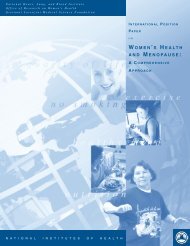HeartsNParks Community Mobilization Guide - National Heart, Lung ...
HeartsNParks Community Mobilization Guide - National Heart, Lung ...
HeartsNParks Community Mobilization Guide - National Heart, Lung ...
You also want an ePaper? Increase the reach of your titles
YUMPU automatically turns print PDFs into web optimized ePapers that Google loves.
lungs and burn off extra calories. These<br />
kinds of activities are called aerobic—<br />
meaning the body uses oxygen to produce<br />
the energy needed for the activity. Other<br />
activities may give you benefits such as<br />
increased flexibility or muscle strength,<br />
depending on the type of activity.<br />
7 False. Although we tend to become less<br />
active with age, physical activity is still<br />
important. In fact, regular physical activity<br />
in older persons increases their capacity to<br />
do everyday activities. In general, middleaged<br />
and older people benefit from regular<br />
physical activity just as young people do.<br />
What is important, NO matter what your<br />
age is tailoring the activity program to<br />
your own fitness level.<br />
8 True. Many activities require little or no<br />
equipment. For example, brisk walking<br />
only requires a comfortable pair of walking<br />
shoes. Also, many communities offer free<br />
or inexpensive recreation facilities and<br />
physical activity classes. Shopping malls,<br />
make ideal walking environments as many<br />
of them are open early and late for people<br />
who do not wish to walk alone, in the<br />
dark, or in bad weather.<br />
9 False. The most common exercise risk is<br />
injury to the muscles and joints. Such<br />
injuries are usually caused by exercising<br />
too hard for too long, particularly if a<br />
person has been inactive for some time. To<br />
avoid injuries, try to build up your level of<br />
activity gradually; listen to your body for<br />
early warning pains; be aware of possible<br />
signs of heart problems (such as pain or<br />
pressure in the left or mid-chest area, left<br />
neck, shoulder, or arm during or just after<br />
exercising, or sudden light-headedness,<br />
cold sweat, pallor, or fainting); and be prepared<br />
for special weather<br />
conditions.<br />
10 True. You should ask your doctor before<br />
you start (or greatly increase) your physical<br />
activity if you have a medical condition<br />
such as high blood pressure, have pains or<br />
pressure in the chest and shoulder area,<br />
tend to feel dizzy or faint, get very breathless<br />
after mild exertion, are middle-aged or<br />
older and have not been physically active,<br />
or plan a fairly vigorous activity program.<br />
If none of these apply, start slow and get<br />
moving.<br />
11 False. Regular, physical activity can help<br />
reduce your risk of having another heart<br />
attack. People who include regular physical<br />
activity in their lives after a heart attack<br />
improve their chances of survival and can<br />
improve how they feel and look. If you<br />
have had a heart attack, consult your<br />
doctor to be sure you are following a safe<br />
and effective exercise program that will<br />
help prevent heart pain and further<br />
damage from overexertion.<br />
12 True. Pick several different activities that<br />
you like doing, because you will be more<br />
likely to stay with a regular regimen. Plan<br />
short-term as well as long-term goals.<br />
Keep a record of your progress, and check<br />
it regularly to see the progress you have<br />
made. Get your family and friends to join<br />
in. They can help keep you going.<br />
NHLBI Health Information Center<br />
P.O. Box 30105, Bethesda, MD 20824-0105<br />
phone: (301) 592-8573 fax: (301) 592-8563<br />
Physical Activity 47
















